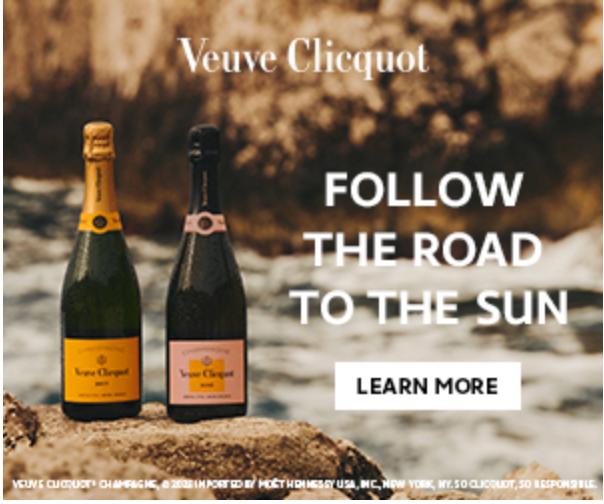A.O.C. Presents Valentine’s Day Dinner in West Hollywood & Brentwood
Suzanne Goin’s Decadent Four-Course Dinner Designed for Two
A.O.C., by Chef Suzanne Goin and business partner Caroline Styne, 3rd Street and Brentwood
Indulgent four-course A.O.C. Valentine’s Day celebration dinner
Chef Suzanne Goin designs an indulgent four-course Valentine’s Day celebration dinner available for dine-in and delivery on Tuesday, February 14, 2023.
The evening begins with a delicious trio of dishes to savor – Blood Orange with Avocado, Cilantro & Crème Fraîche; Charred Albacore on Lavash with Lemongrass, Kumquat & Cashews; and a Stack of Cheesy Focaccia with Jamon & Black Truffle.
Next is a course of Nettle Gnocchi with Maine Lobster, Pecorino & Sugar Snaps.
For the main course, each guest can choose from Turmeric-Grilled Oyster Mushrooms with 2 Peas’ Broccoli, Pistachio & Calabrian Chiles; Striped Bass with Roasted Beets, Fennel & Citrus Chutney; Stuffed Chicken with Morels, Country Bread & Stewed Leeks; or Slow-Roasted Beef Tenderloin with Red Wine Red Cabbage & Horseradish Cream.
Leave lots of room for the sweet ending – Ode to the Samoa Cookie for Two – Chocolate, Dulce De Leche & Coconut Ice Cream.
The dinner is priced at $150 per person, excluding beverages, tax and gratuity; reservations are offered from 5:00 p.m. – 10.30 p.m.
Head Barman Ignacio Murillo’s Valentine’s Cocktail for Two
Enhance the dinner with Head Barman Ignacio Murillo’s Valentine’s Cocktail for Two – Flor de Passion with Hibiscus-Infused Mezcal, Kumquat Cordial & Lime. To pair with the dinner, Caroline Styne has selected a flight of her favorite Rosé Champagnes— J. Lassalle, Brut Rosé, 1er Cru, Billecart-Salmon, Brut Rosé and Lanson Pink Label, Brut Rosé, and a curated list of recommended wines by the glass or bottle offered at a supplementary charge.
Vegan and Vegetarian options are available; please note these preferences when making reservations.
The public can book reservations on OpenTable.com and require advance payment.
a.o.c. valentine’s day dinner
february 14, 2023
$150 per person
vegetarian option available
to share
blood orange, avocado, cilantro & crème fraîche
charred albacore on lavash, lemongrass, kumquat & cashews
stack of cheesy focaccia, jamon & black truffle
***
nettle gnocchi, maine lobster, pecorino & sugar snaps
***
choice of
turmeric-grilled oyster mushrooms, 2 peas’ broccoli, pistachio & calabrian chiles
or
striped bass, roasted beets, fennel & citrus chutney
or
stuffed chicken, morels, country bread & stewed leeks
or
slow-roasted beef tenderloin, red wine red cabbage & horseradish cream
***
ode to the samoa cookie for two
chocolate, dulce de leche & coconut ice cream
featuring
valentine’s day cocktail – flor de passion
Sparkling Rosé Flight & Wine Flight, curated by Caroline Styne
(supplemental charge)
WHEN:
Valentine’s Day
Tuesday, February 14, 2023
5:00 p.m. – 10.30 p.m.
A.O.C. 3rd Street
8700 W. 3rd Street, Los Angeles, CA 90048 – 310.859.9859
A.O.C. Brentwood
11648 San Vicente Blvd., Los Angeles, CA 90049 – 310.806.6464
ABOUT THE LUCQUES GROUP:
With the opening of Lucques, their flagship restaurant, in 1998, James Beard Foundation award-winning Chef/Author Suzanne Goin and award-winning Restaurateur Caroline Styne planted the seeds for The Lucques Group, a Los Angeles hospitality company that comprises two fine dining restaurants – A.O.C. in both Los Angeles and Brentwood.
Along with these culinary enterprises, the company also owns the Larder Baking Company and oversees Hollywood Bowl Food + Wine, which curates all the food and beverage outlets at L.A.’s iconic music venue.
The duo also operates two restaurants – Caldo Verde and Cara Cara – at the Downtown L.A. Proper Hotel.
The Lucques Group is dedicated to seasonally influenced cooking and focuses on sourcing local, organic produce from which Goin creates soulful dishes that are bold in flavor, vibrant, layered and complex.
For further information and complete menus for a.o.c.,
visit www.aocwinebar.com




